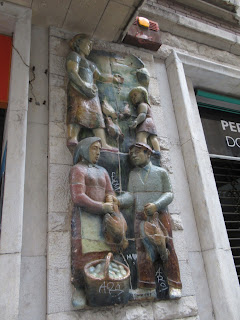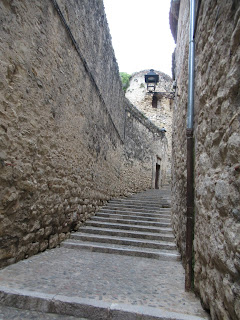After a fantastic time in Barcelona, we took the train a short distance northeast to Girona in Spain's Costa Brava region near the country's border with France. Girona, northern Catalunya's largest city, was a former Roman town taken from the Muslims by the Franks in the late 8th century. The city's wealth in the medieval period produced many fine Romanesque and Gothic buildings that survived repeated attacks and sieges.
We only planned to walk around the old city for a few hours before picking up a rental car and driving further north to see more of Costa Brava. We noticed these guild signs all on one street as we walked toward the old city.
If you read my recent Barcelona posts, you'll no doubt recognize the Catalunya flag and one story behind the red stripes.
Girona's old town should be nicknamed The City of a 1,000 Steps!
Over the main entrance was the unusual placement of the tomb of Barcelona Count Ramon Berenguer II who was born in 1053 and died after being assassinated in 1082.
The uneven cobblestone streets were so pretty but tough for walking on.
Since the 13th century, the Jewish community of Girona owned some land north of the city which fulfilled the necessary requirements of purity, a location outside the city walls, in uncultivated lands, and a slope and near a current of water for a Jewish cemetery. Until 1492, Girona's Jews buried their dead along the slopes at Montjuic, the area north of Barcelona whose name meant the Jewish mountain that we'd visited several days earlier.
The two-sided Columbus Sculpture in the courtyard behind the museum noted that 1492 was both a year of exploration and of expulsion for Spain's Jews, two simultaneous journeys that were separate but closely linked. One side, in dark bronze and gold, had navigational instruments, maps and writings of Jewish scholars and mapmakers from Spain.
On the other side, in contrasting bright silver, stood Columbus on his flagship boat, the Santa Maria, that led to a 'New World' of much greater religious freedom and toleration.
I certainly never realized these two momentous events - the expulsion of the Jews and the expedition to discover new lands - were commanded by the Catholic monarchs on successive days, on March 30 and 31, 1492. Yet without the Jewish mapmakers and instrument makers, Columbus' journey of discovery would have failed.
If we'd had more time, it would have been ideal to spend a full day wandering through more of Girona as it was a lovely, lovely medieval town that we were enthralled by.
We only planned to walk around the old city for a few hours before picking up a rental car and driving further north to see more of Costa Brava. We noticed these guild signs all on one street as we walked toward the old city.
Though our luck with the lousy weather persisted, the scene that greeted us as we walked across the beautiful Onya River made us smile.
The yellow ribbon denoted support for Catalunya self rule, i.e. against the Spanish government.
While walking along the pretty pedestrian street, it was impossible to miss the signs, not only in favor of independence for Catalunya, but also for maintaining the city's heritage and not converting so many older residences into apartments for tourists, i.e. pisos turisticos.
If you read my recent Barcelona posts, you'll no doubt recognize the Catalunya flag and one story behind the red stripes.
We thought climbing up all these steps would take us to the Girona Cathedral. After huffing and puffing our way up the steps, we realized it wasn't and the Cathedral was still ahead.
After being in the major metropolis of Barcelona for almost a week, it was glorious wandering the back alleys of the relatively small town of Girona.
Even though Barcelona is the capital of Catalunya, it felt like Girona was its heart, judging from the profusion of signs, flags and ribbons we saw.
Girona's old town should be nicknamed The City of a 1,000 Steps!
Yeah - THE Girona Cathedral at last, albeit via the far less impressive side entrance. Built over an old Roman forum, parts of the cathedral's foundations dated from the 5th century but Gothic styling from the 14th century dominated.
One of the highlights of the cathedral was the 14th century silver balduchin, studded with gemstones, that portrayed 16 scenes from Christ's life.
The nave was ringed by elaborate chapels on both sides.
In St. Ursula's Chapel was Christ lying in the sepulcher and the 16th century Tapestry of the Resurrection.
Suellen: I thought of you and Grace as we left via the cathedral's main door and heard and saw a marching band and a parade go right by the Placa de la Catedral at the bottom of the 86 steps!
Us trying to perfect the selfie shot with the top of the cathedral in the background. Clearly, we needed more practice!
Walking along the city's ancient cobblestone streets was like a walk through time.
We only glanced quickly at the 12th century Arab Baths knowing we'd seen many others in our previous travels and were also pressed for time in Girona.
Since the old town was so small, we had no trouble hearing the cathedral's bells chime for a full 30 minutes nonstop. I think that was the longest time we've ever heard bells peal!
You think we should have known as we climbed these steps, that we'd just happen onto another church, right? But no, we were slow learners and were totally surprised when we opened a small door in a back alley to find it was Girona's Basilica de San Felipe and a televised Mass was being celebrated with about 25 priests! I was surprised to find the church was packed to the rafters for the 11 am mass on a Monday. Perhaps it was a feast day I was unaware of.
Again, we exited by the front and more steps! I wondered how such a relatively small old town could support both a huge cathedral and a huge basilica in such close proximity to each other.
The uneven cobblestone streets were so pretty but tough for walking on.
Just steps from the cathedral was what remained of Girona's Jewish Quarter. In its 13th century heyday, Girona was home to one of Catalunya's largest Jewish communities which lived generally peacefully alongside its Christian neighbors. Though it gained in prosperity and contributed to fields as diverse as astronomy and medicine, the Jewish community still came under attack especially during the crusades. The quarter, known as the Call as we also learned it had been in Barcelona, was a maze of tiny alleys surrounded by a stone wall. While the Call had once been a refuge, it became a ghetto as Jews were gradually confined to their tiny area of town.
A riot occurred in 1391 in which a mob broke into the ghetto and massacred 40 residents. As the Jews were still under the king's protection, troops were sent in and the survivors were confined to the Galligants Tower 'for their own safety' for 17 weeks. When they left, they discovered their homes and possessions had been destroyed. Many Jews converted to Christianity during the 15th century. In 1492, those that remained in Girona were expelled from Spain in one of the saddest chapters in the country's history.
We spent some time at the excellent Girona Jewish History Museum and learned that the Jews began to populate the Mediterranean coast at the beginning of the Roman Empire and arrived in Girona at the end of the 9th century. I read that interest in the city's Jewish past was only rekindled in the 1970s but no information was provided as to what precipitated that happening then.
In the museum were tombstones from the Jewish cemetery in Girona that contained beautiful written epitaphs in remembrance of the men, women and children who had once lived in the city.
We didn't realize when we were at Montjuic that when the Jews were expelled, they were forced to give up the cemetery and donated it to Joan de Sarriera. The land during the next five centuries kept almost the same structure as it had when it was the Girona Jewish cemetery.
Seeing the poster about Sant Narcis in one of the shops made sense why we had seen the parade and marching band earlier outside the cathedral. It turns out the saint, who was born on October 29th, 307, is much venerated only in Girona. I didn't feel so badly about not knowing of his existence!
What a wet and chilly day it was to be selling local cheeses and other delicacies.
Next post: The still blooming Gardens of Cap Roig in Palafrugell on the Costa Brava that afternoon.
Posted on December 5th , 2018, from Sevilla, our last night after six pretty wonderful weeks in Spain.




















































































Nice, Annie. I looked up Oct 29th and discovered Saint Narcissus, certainly a little known saint for most of us; I see you found out that was why the churches were filled that Monday. Somehow he has a special place in Girona, which does indeed look like a beautiful town!
ReplyDeleteAndrew,
ReplyDeleteIt was certainly blind luck we happened to pick months and months ago to visit Girona on October 29th, the feast day for St. Narcissus! Neat the way these things happen at times when we're traveling.
XOXO, big brother